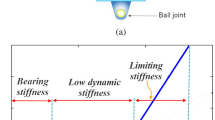Abstract
Purpose
Magnetic levitation vibration isolator (MLVI) is an efficient method to suppress the external oscillations transmitted to some small instruments in the laboratories.
Methods
This paper first presents a basic configuration of a kind of MLVI with four sets of the repulsive rectangular permanent magnets. Then, the parametric studies are carried out to discuss how the structure and air gap parameters influence the magnetic force, stiffness, and natural frequency of the MLVI. Moreover, as an MLVI case study, an operating point is set and the size dimensions of the MLVI are determined based on the parametric studies. The transmissibility of the MLVI is calculated by the dynamic equation at the operating point.
Results
An experimental table is constructed for the analytical validation. The experimental results proved the validity of the theoretical analysis and showed that there are good consistencies between the experiment results and the theoretical calculation, which obtains that the natural frequency of the MLVI is 4.75 Hz and the initial cut-off frequency of the MLVI is approximately 6 Hz at the operating point. When the frequency of the external oscillations reaches 16 Hz, the attenuation amplitude becomes − 20 dB.
Conclusion
All of these show ability of the proposed MLVI to attain low-frequency vibration isolation, and provide a new type of basic passive MLVI to exploit an active MLVI for practical applications.















Similar content being viewed by others
References
Cheng C, Li S, Wang Y, Jiang X (2018) Resonance Response of a quasi-zero stiffness vibration isolator considering a constant force. J Vib Eng Technol 6(6):471–481
Li F, Chen Q, Zhou JH (2018) Dynamic properties of a novel vibration isolator with negative stiffness. J Vib Eng Technol 6(3):239–247
Wang Y, Li S, Jiang X, Cheng C (2017) Resonance and performance analysis of a harmonically forced quasi-zero-stiffness vibration isolator considering the effect of mistuned mass. J Vib Eng Technol 5(1):45–60
Carrella A, Brennan MJ, Waters TP, Shin K (2008) On the design of a high-static-low-dynamic stiffness isolator using linear mechanical springs and magnets. J Sound Vib 315(3):712–720
Lee JH, Kim KJ (2007) Modeling of nonlinear complex stiffness of dual-chamber pneumatic spring for precision vibration isolations. J Sound Vib 301(3–5):909–926
Shen X, Chen Y, Wang J, Li J, Chang L, Sun Y (2019) Design, experiment and verification of resonant frequency-tunable vibration based on annular metal rubbers and shaped alloy actuators. J Vib Eng Technol 7(3):277–289
Zeng X, Zhang L, Yu Y, Shi M, Zhou J (2016) The stiffness and damping characteristic of dual-chamber air spring device applied to motion suppression of marine structures. Appl Sci 6(3):1–20
Puppin E, Fratello V (2002) Vibration isolation with magnet springs. Rev Sci Instrum 73(11):4034–4036
Bonisoli E, Vigliani A (2007) Passive elasto-magnetic suspensions: nonlinear models and experimental outcomes. Mech Res Commun 37(4):385–394
Zhang S, Huang J, Yang J (2019) Raising power loss equalizing degree of coil array by convex quadratic optimiza tion commutation of magnetic levitation planar motors. Appl Sci 9(1):79
Zhu Y, Li Q, Xu D, Zhang M (2012) Modeling and analysis of a negative stiffness magnetic suspension vibration isolator with experimental investigations. Rev Sci Instrum 83:095108
Li Q, Zhu Y, Xu D, Hu J, Min W, Pang L (2013) A negative stiffness vibration isolator using magnetics spring combined with rubber membrane. J Mech Sci Technol 27(3):813–824
Shin K (2014) On the performance of a single degree-of- freedom high-static-low-dynamic stiffness magnetic vibration isolator. Int J Precis Eng Man 15(3):439–445
Dong G, Zhang X, Xie S, Yan B, Luo Y (2017) Simulated and experimental studies on a high-low-dynamic stiffness isolator using magnetic negative stiffness spring. Mech-Syst Signal Process 86:188–203
Choi KB, Cho YG, Shishi T, Shimokohbe A (2003) Stabilization of one degree-of- freedom control type levitation table with magnet repulsive forces. Mechatronics 13(6):587–603
Zhu Y, Li Q, Xu D, Zhang M (2012) Modeling of axial magnetic force and stiffness of ring-shaped permanent magnet passive vibration isolator and its vibration experiment. IEEE Trans Magn 48(7):2228–2238
Ravaud R, Lemarquand G, Babic S, Lemarquand V, Akyel C (2010) Cylindrical magnets and coils: fields, forces and inductances. IEEE Trans Magn 46(9):3585–3590
Yonnet J-P (1981) Permanent magnet bearings and couples. IEEE Trans Magn 17(1):1169–1173
Ravaud R, Lemarquand G, Lemarquand V (2009) Force and stiffness of passive magnetic bearings using permanent magnets: part1: axial magnetization. IEEE Trans Magn 45(7):2996–3002
Ravaud R, Lemarquand G, Lemarquand V (2009) Force and stiffness of passive magnetic bearings using permanent magnets: part2: radial magnetization. IEEE Trans Magn. 45(9):2996–3002
Akoun G, Yonnet J-P (1984) 3D analytical calculation of the forces exerted from two cubical magnets. IEEE Trans Magn 20(5):1962–1964
Van Casteren DTEH, Paulides JJH, Janssen JLG, Lomonova EA (2015) Analytical force, stiffness, and resonance frequency calculation of a magnetic vibration isolator for a microbalance. IEEE Trans Ind Appl 51(1):204–210
Acknowledgements
This work was supported by Major Scientific and Technological Project of China National Machinery Industry Corporation Ltd (SINOMAST-ZDZX-2017-05), and National Science and Technology Major Project (2013ZX02104003) and the National Science Foundation of Hubei Province (2018CFC889) and the Scientific Project of Hubei Provincial Department of Education (E2018313).
Author information
Authors and Affiliations
Corresponding author
Ethics declarations
Conflict of Interest
The authors declare that they have no conflict of interest.
Additional information
Publisher's Note
Springer Nature remains neutral with regard to jurisdictional claims in published maps and institutional affiliations.
Rights and permissions
About this article
Cite this article
Li, Q., Li, S., Li, F. et al. Analysis and Experiment of Vibration Isolation Performance of a Magnetic Levitation Vibration Isolator with Rectangular Permanent Magnets. J. Vib. Eng. Technol. 8, 751–760 (2020). https://doi.org/10.1007/s42417-019-00188-z
Received:
Revised:
Accepted:
Published:
Issue Date:
DOI: https://doi.org/10.1007/s42417-019-00188-z




